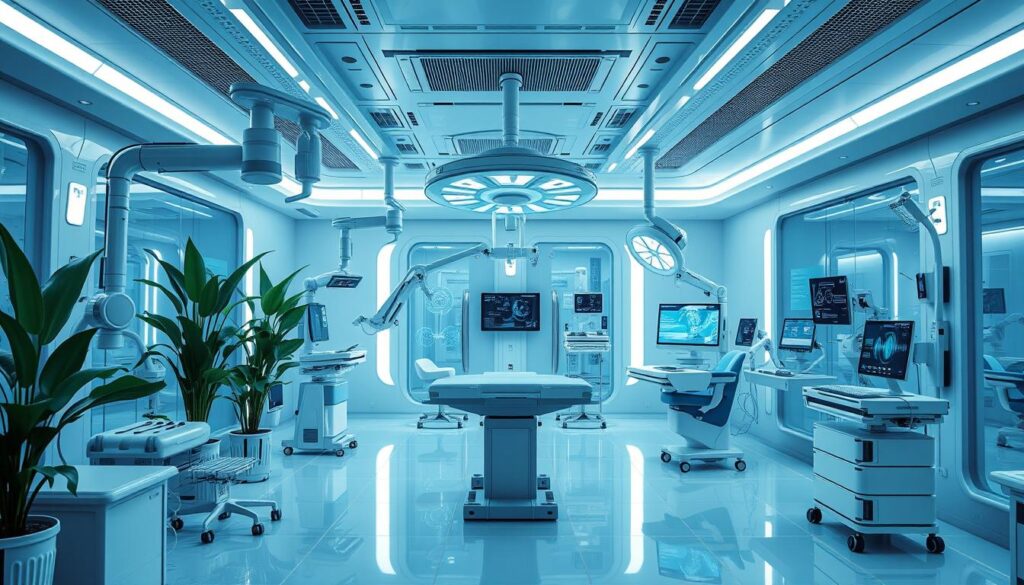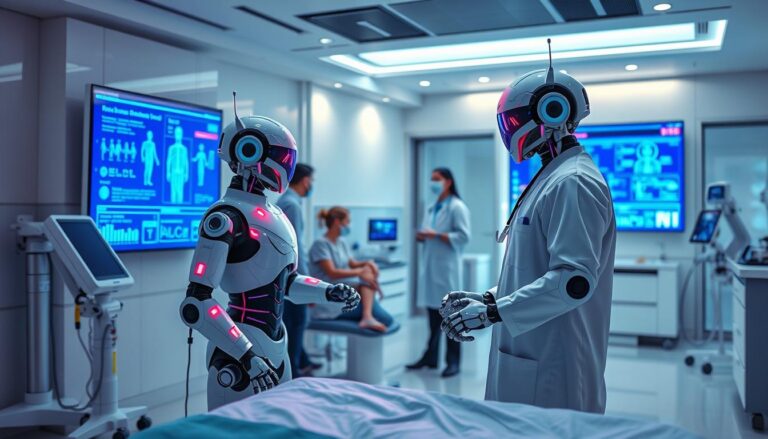The use of artificial intelligence in healthcare is changing the medical world. Osteopathic medicine is also seeing big changes. The new Kansas osteopathic artificial intelligence course is leading this change. It teaches students about the latest technologies and how they help in patient care, especially in osteopathic medicine.
This course combines osteopathic principles with artificial intelligence. It aims to make patient care better and improve healthcare quality. This new way of learning is set to change medical education. Its impact on osteopathic medicine’s future is huge.
The course prepares students for a fast-changing medical world. As more people need skilled healthcare workers, this course is key. It’s helping shape the future of osteopathic medicine.
Understanding the Kansas Osteopathic Artificial Intelligence Course
The Kansas osteopathic artificial intelligence course is made for osteopathic medical students and professionals. It teaches them about artificial intelligence and its use in healthcare. This course is a big step in medical education, helping students understand the complex world of healthcare technology.
The course talks about the basics of artificial intelligence, machine learning, and data analytics. Students learn how to use these ideas to solve real healthcare problems. They also learn about the ethics of using artificial intelligence in healthcare.

The course mixes theory and practice. Students will do lectures, discussions, and hands-on activities. They’ll also have lab sessions and practice in clinics. The course is made for working professionals, with flexible times and online options.
Key topics include:
- Introduction to artificial intelligence and machine learning
- Applications of artificial intelligence in healthcare
- Data analytics and visualization
- Ethical considerations in healthcare technology
By the end, students will know a lot about artificial intelligence in medical education and healthcare technology. They’ll also have the skills to use these ideas in real life.
The Integration of AI in Osteopathic Medicine
Artificial intelligence is changing osteopathic medicine. It helps doctors give more tailored and effective patient care. AI lets osteopathic doctors look at lots of data, find patterns, and make better diagnoses. This leads to healthcare innovation and better health for patients.
AI is used in many ways in osteopathic medicine:
- Diagnosis: AI algorithms help doctors diagnose faster and more accurately.
- Treatment planning: AI helps create treatment plans that fit each patient’s needs.
- Patient monitoring: AI systems watch patients from afar, so doctors can quickly respond to any changes.
As AI gets better, it will play a bigger role in patient care and healthcare innovation. By using AI, osteopathic doctors can lead in medical innovation and give the best care to their patients.
Adding AI to osteopathic medicine is a big step forward. It’s key to keep exploring how it can improve patient care and healthcare innovation. As research and development grow, we’ll see more AI uses in osteopathic medicine.
| Application | Benefits |
|---|---|
| Diagnosis | Improved accuracy, faster diagnosis |
| Treatment planning | Personalized treatment plans, better patient outcomes |
| Patient monitoring | Remote monitoring, prompt response to changes in condition |
Advanced Technology Applications in Patient Care
Artificial intelligence is changing healthcare, especially in medical diagnostics. It helps doctors improve care, cut down on mistakes, and boost patient results. AI brings new tools for diagnosing, planning treatments, and keeping an eye on patients.
Some of the main uses of AI in healthcare include:
- Diagnostic support systems that use machine learning to spot health problems from medical images
- Treatment planning optimization that creates custom plans for patients using AI
- Patient monitoring solutions that track vital signs and alert doctors to health issues with sensors and AI
These technologies could change patient care for the better. They make care more efficient, effective, and focused on the patient. By using AI, healthcare can offer better results, lower costs, and higher quality care.
Diagnostic Support Systems
Diagnostic support systems are a big part of AI in healthcare. They use machine learning to look at medical images like X-rays and MRIs. This helps doctors find health problems faster and more accurately.
Kansas Healthcare Innovation Hub
The Kansas healthcare innovation hub is a leading center that encourages innovation. It helps develop new healthcare technology solutions. Here, healthcare experts, researchers, and entrepreneurs work together to improve patient care.
This place is all about sharing ideas and resources. It leads to the creation of innovative solutions for healthcare challenges.
The hub is focused on advancing healthcare technology and supporting startups. It offers funding, mentorship, and access to top-notch equipment. This helps companies bring new products to the market.
By working together, the hub aims to make a big difference in healthcare. It’s all about growing and improving patient care.
Some key features of the Kansas healthcare innovation hub include:
- Collaborative workspaces and meeting facilities
- Access to funding opportunities and investment networks
- Mentorship programs and networking events
- State-of-the-art equipment and facilities
The Kansas healthcare innovation hub is an innovation hub focused on healthcare. It supports innovation and entrepreneurship. The hub helps develop new healthcare technology solutions, leading to better patient care and healthcare quality.
Practical Skills and Hands-on Training Components
The Kansas osteopathic artificial intelligence course focuses on practical skills and hands-on training. It aims to prepare students for real-world healthcare use of AI. The course offers a full learning experience, bridging theory and practice.
Students learn through lab sessions, clinical practice, and assessments. This way, they understand AI’s role in patient care. The course’s hands-on training helps students develop essential practical skills for complex healthcare scenarios.
Key Components of the Kansas Osteopathic Artificial Intelligence Course
- Laboratory sessions: providing students with a hands-on experience in AI applications
- Clinical practice integration: allowing students to apply theoretical knowledge in real-world settings
- Assessment methods: evaluating student learning and providing feedback for improvement
This course prepares students for modern healthcare challenges. It focuses on practical skills and hands-on training. This makes the Kansas osteopathic artificial intelligence course unique and valuable.
Conclusion: Shaping the Future of Osteopathic Medicine Through Technology
The Kansas Osteopathic Artificial Intelligence Course is a big step forward. It combines technology and innovation in osteopathic medicine. This course teaches healthcare pros how to use advanced technologies like AI and data analytics.
This means a big change for osteopathic medicine’s future. It will help doctors and patients in many ways. The course focuses on real-world skills to improve patient care and treatment plans.
As technology integration grows in healthcare, this course keeps osteopathic doctors ahead. They will lead in making osteopathic medicine better. This will help patients get the best care possible.
The Kansas Osteopathic Artificial Intelligence Course is all about innovation and advanced technologies. It’s ready to change osteopathic medicine for the better. As healthcare keeps changing, this course shows how technology integration can make a big difference.
FAQ
What is the Kansas Osteopathic Artificial Intelligence Course?
The Kansas Osteopathic Artificial Intelligence Course is a new program. It aims to mix artificial intelligence (AI) with osteopathic medicine. This gives students a deep understanding of new technologies and how they help in patient care.
What are the core objectives and goals of the course?
The course’s main goals are to boost medical education and better patient care. It also aims to bring new ideas to the healthcare world. By combining AI with osteopathic principles, it prepares students to use technology for better patient care.
Who is the target audience for the course?
The course is for osteopathic medical students and professionals. It’s for those who want to learn about AI in healthcare. You need a background in osteopathic medicine or a related field to join.
What is the duration and structure of the course?
The course is designed to give a full view of AI in osteopathic medicine. It mixes classroom learning, lab sessions, and clinical practice. This approach focuses on practical learning and applying what you learn.
How will AI be integrated into osteopathic medicine?
AI will be used in many parts of osteopathic medicine. This includes helping with diagnosis, planning treatments, monitoring patients, and analyzing data. These tools aim to make patient care better, cut down on mistakes, and improve healthcare quality.
What are the advanced technology applications in patient care?
The course covers many advanced technologies. These include tools for diagnosis, planning treatments, monitoring patients, and data analysis. These technologies aim to improve patient care, lower costs, and drive new ideas in osteopathic medicine.
What is the Kansas Healthcare Innovation Hub?
The Kansas Healthcare Innovation Hub supports innovation and entrepreneurship in healthcare. It’s a place where healthcare experts, researchers, and entrepreneurs can work together. The goal is to create new healthcare solutions, leading to better patient care and healthcare quality.
What are the practical skills and hands-on training components of the course?
The course has lab sessions, clinical practice, and assessment methods. These are designed to give students practical experience. They help students learn to apply AI and other advanced technologies in real healthcare settings.


